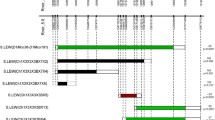Abstract
The genes that determine the baseline hematocrit level in humans and experimental animals are unknown. The spontaneously hypertensive rat (SHR), the most widely used animal model of human essential hypertension, exhibits an increased hematocrit when compared with the normotensive Brown Norway (BN-Lx) strain (0.54 ± 0.02 vs. 0.44 ± 0.02, p < 0.01). Distribution of hematocrit values among recombinant inbred (RI) strains derived from SHR and BN-Lx progenitors was continuous, which suggests a polygenic mode of inheritance. The narrow heritability of the hematocrit was estimated to be 0.32. The Eno2 marker on Chromosome (Chr) 4 showed the strongest association (p < 00001) with the observed variability of hematocrit among RI strains. The erythropoietin (Epo) gene, originally reported to be syntenic with Eno2, has been mapped to Chr 12, thus excluding it as a potential candidate gene for the increased hematocrit in the SHR. The current linkage data extend homologies between rat, mouse, and human chromosomes.
Similar content being viewed by others
References
Belknap JK, Mitchell SR, O’Toole LA, Helms ML, Crabbe JC (1996) Type I and type II error rates for quantitative trait loci (QTL) mapping studies using recombinant inbred mouse strains. Behav Genet 26, 149–160
Bottger A, van Lith HA, Kren V, Krenová D, Bílá V, Vorlícek J, Zídek V, Musilová A, Zdobinská M, Wang J-M, van Zutphen LFM, Kurtz TW, Pravenec M (1996) Quantitative trait loci influencing cholesterol and phospholipid phenotypes map to chromosomes that contain genes regulating blood pressure in the spontaneously hypertensitve rat. J Clin Invest 98, 856–862
Brushi G, Minari M, Bruschi ME, Tacinelli L, Milani B, Cavatorta A, Borghetti A (1986) Similarities of essential and spontaneous hypertension: volume and number of red blood cells. Hypertension 8, 983–989
Cirillo M, Lauranzi M, Trevisan M (1992) Hematocrit, blood pressure, and hypertension. The Gubbio population study. Hypertension 20, 319–326
Huang C, Davis G, Johns EJ (1993). Role of haematocrit in mediating the actions of chronic erythropoietin treatment on blood pressure and renal haemodynamics in the rat. Clin Sci 85, 717–724
Klingmuller U, Lorenz U, Cantley LC, Neel BG, Lodish HF (1995) Specific recruitment of SH-PTP1 to the erythropoietin receptor causes in-activation of JAK2 and termination of proliferative signals. Cell 80, 729–738
Kozak CA, Bucan M, Goffinet A, Stephenson DA (1996) Mouse chromosome 5. Mamm Genome 6(Suppl), S97-S112
Letcher G, Bergentz SE, Bjure J, Wilhelmsen L (1966) Hematocrit, plasma protein, and viscosity in early hypertensive disease. Am Heart J 72, 165–176
Letcher RL, Chien S, Pickering TG, Laragh JH (1983) Elevated blood viscosity in patients with borderline essential hypertension. Hypertension 5, 757–762
Levan G, Szpirer J, Szpirer C, Klinga K, Hanson C, Islam Q (1991) The gene map of the Norway rat (Rattus norvegicus) and comparative mapping with mouse and man. Genomics 10, 699–718
Maes M, Scharpe S, Cooreman W, Wauters A, Neels H, Verkerk R, De Meyer F, D’Hondt P, Peeters D, Cosyns P (1995) Components of biological, including seasonal, variation in hematological measurements and plasma fibrinogen concentrations in normal humans. Experientia 51, 141–149
McDonough JR, James CG, Garrison GE, Stubb SC, Lichtman M, Hefelfinger DC (1965) The relationship of hematocrit to cardiovascular states of health in the Negro and white population of Evans County, Georgia. J Chronic Dis 18, 243–257
Moore KJ, Elliot RW (1996) Mouse chromosome 6. Mamm Genome 6(Suppl), S113-S134
Nagao M, Suga H, Okano M, Masuda S, Narita H, Ikura K, Sasaki R (1992) Nucleotide sequence of rat erythropoietin. Biochim Biophys Acta 1171, 99–102
Neumann PE (1990) Two-locus linkage analysis using recombinant inbred strains and Bayes’ theorem. Genetics 126, 277–284
Plomin R, McClearn, GE (1993) Quantitative trait loci (QTL) analyses and alcohol-related behaviors. Behav Genet 23, 197–211
Pravenec M, Klír P, Kren V, Zicha J, Kuneš J (1989) An analysis of spontaneous hypertension in spontaneously hypertensive rats by means of new recombinant inbred strains. J Hypertens 7, 217–222
Pravenec M, Gauguier D, Schott J-J, Buard J, Kren V, Bílá V, Szpirer C, Szpirer J, Wang JM, Huang H, St. Lezin E, Spence MA, Flodman A, Printz M, Lathrop GM, Vergnaud G, Kurtz TW (1996) A genetic linkage map of the rat derived from recombinant inbred strains. Mamm Genome 7, 117–127
Sen S, Hoffman GC, Stowe NT, Smeby RR, Bumpus FM (1972) Eryth-rocytosis in spontaneously hypertensive rats. J Clin Invest 51, 710–714
Shoemaker CB, Mitsock LD (1986) Murine erythropoietin gene: cloning, expression, and human gene homology. Mol Cell Biol 6, 849–858
Smith S, Julius S, Jamerson K, Amerena J, Schork N (1994) Hematocrit levels and physiologic factors in relationship to cardiovascular risk in Tacumseh, Michigan. J Hypertens 12, 455–462
Wannamethee G, Shaper AG (1994) Haematocrit: relationship with blood lipids, blood pressure and other cardiovascular risk factors. Thromb Haemostasis 72, 58–64
Whitfield JB, Martin NG (1985) Genetic and environmental influences on the size and number of cells in the blood. Genet Epidemiol 2, 133–144
Author information
Authors and Affiliations
Rights and permissions
About this article
Cite this article
Pravenec, M., Zidek, V., Zdobinska, M. et al. Mapping genes controlling hematocrit in the spontaneously hypertensive rat. Mammalian Genome 8, 387–389 (1997). https://doi.org/10.1007/s003359900452
Received:
Accepted:
Issue Date:
DOI: https://doi.org/10.1007/s003359900452




